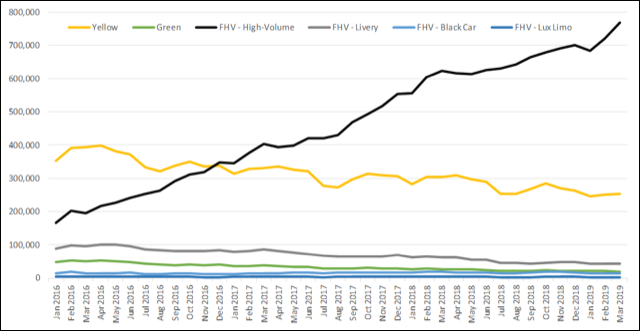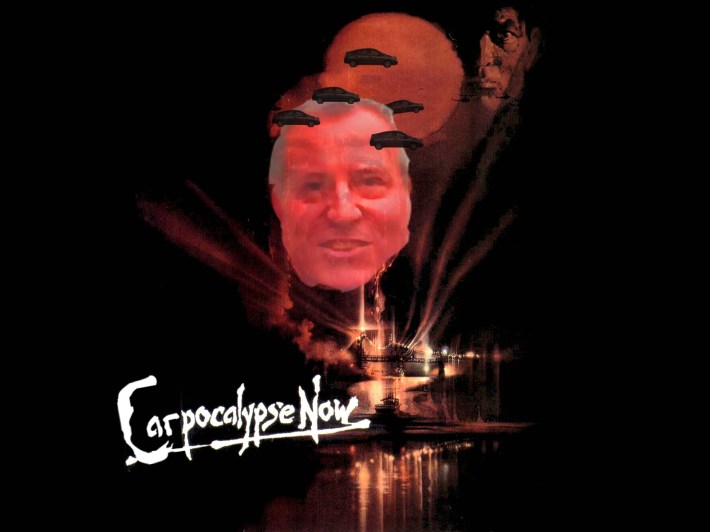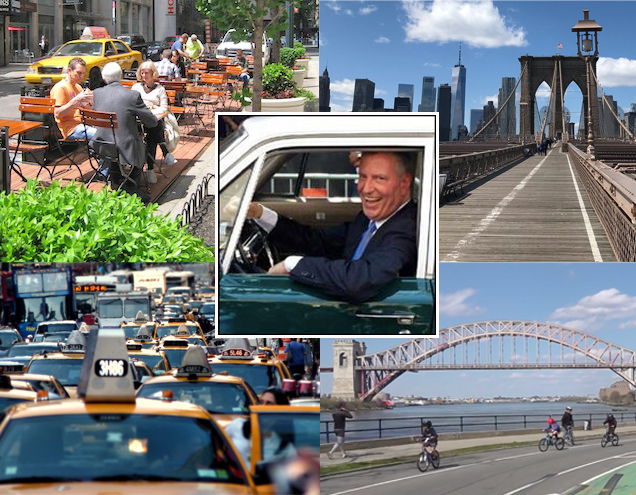When this is all over, will we be a city for cars or a city for people?
Plenty of New Yorkers are contemplating buying cars, or have already done so, to help them avoid subways and buses during the COVID-19 crisis. Transit ridership — already in decline before the crisis — is expected to get back up to 60 percent of normal after the crisis subsides. Private companies are planning new commuting strategies that include new satellite offices to allow suburbanites to drive to work rather than take trains into the city.
The result is going to be a region filled with more cars, more pollution and more death on the roadways — all of which could be mitigated with forethought by government. Operative word: could.
"We know what New York City looks like when people can’t or won’t use the subway, and some try to substitute car travel,” said Jon Orcutt, who served as policy director at the Department of Transportation during the Bloomberg Administration. "The weeks after 9/11 saw lines of congested traffic reaching from Manhattan back to the Nassau and Westchester County suburbs. Same in the days following Hurricane Sandy. Our recent history should warn us of what may be coming."
The scale of the problem will require a massive, multi-faceted approach by all levels of government because the MTA predicts that only 60 percent of riders will return by the end of the year (another study says it'll be about 50 percent). If 40 percent of current riders don't return to transit, that amount to:
- 2.2 million subway riders per day.
- 880,000 bus riders per day.
- 150,000 Long Island Rail Road riders per day.
- 120,000 Metro-North riders per day.
Now only a fraction of those three and a half million people will need to get anywhere; many former transit riders will be employees who have the luxury of working from home, workers who have been laid off or furloughed, students who are now taking classes online instead of at schools, tourists who won't be coming back in as high numbers as before or other former subway and bus users who don't need to go anywhere.
But even if a tiny percentage of those millions of commuters switch to cars, the gridlock will be on the Hellish levels that Orcutt talked about. (Case in point: The New York Stock Exchange — as vaunted an institution as this city has, for better or worse — announced on Friday in a Wall Street Journal op-ed that it would reopen its Lower Manhattan trading floor, but "require all comers to avoid public transportation, which will limit their exposure and preserve capacity for others." The NYSE did not return a Friday call from Streetsblog, but it is clear that the news came as a surprise to planners inside the government.)
The city has already witnessed a tiny version of this worst-case scenario — when app-based taxis such as Uber and Lyft congested New York roads with hundreds of thousands more trips per day — and that was before the current crisis.

So how are the city and state preparing for the transportation nightmare on the horizon? Mostly, they're not.
The inequity of cars
According to U.S. Census figures, of the 3.8 million working people in New York, only 27 percent drive themselves to work every day; and just eight percent of Manhattanites do.
Many people who can afford to drive will choose that option, at least until they feel comfortable returning to transit, but owning a car is a financial choice that not every New Yorker can make. If leaders just accept that as a status quo, they'll be building more unfair state and city, said Regional Planning Association Senior Vice President Kate Slevin.
"There's a real danger that the existing inequities in our society become more severe, which you're seeing play out with reports of packed subways right now," said Slevin. "If we ignore public transportation and say, 'Oh everyone can just get a car,' we're ignoring the people who are suffering already."
Mayor de Blasio has made feints towards understanding the problem — "We have to get away from individual automobile use a lot more," he told reporters on April 14 — but what is he doing about it? So far, his administration is creating 100 miles of open streets, but those are only temporary during the COVID-19 pandemic. On the permanent front, the mayor is going in the wrong direction: he slashed DOT's budget by $61.5 million through June, 2021, specifically cutting funding for his own “Better Bus Initiative” and for some of his signature Vision Zero initiative.
"We're concerned about what happens once more people start to come back and if they skip the subway," said DOT Commissioner Polly Trottenberg. "We're thinking hard about how to prioritize getting lot of projects done, more paint, less concrete."
Cars are not just a congestion concern, but a safety concern. Yet the Department of Health isn't part of the planning process regarding the inevitable surge in car use. The agency declined to even discuss the matter with Streetsblog.
That's a mistake. Cars are a serious vector of death.
In a typical year during the de Blasio administration, 42 pedestrians and cyclists would have died between Jan. 1 and May 4. This year, 28 died during that period, a decrease of 33 percent — almost entirely due to decrease in driving during the coronavirus.
Pollution will also return when drivers get back on the road. Congestion will fray nerves, reduce productivity, create anxiety and increase the onset of preventable diseases.
“Taking transit is like going to the gym everyday — walking to subway stations, up and down stairs," said former DOT official Sam Schwartz. "The more time you spend in a car the greater likelihood you suffer from preventable diseases like diabetes and cancer and heart disease and obesity."
One tool stays in the box
The city itself will change — and commuting patterns must change with it.
There's already talk of staggered work hours to ease crowding on transit, but there's also the possibility that large Manhattan offices will be broken up into satellite offices around the city — or many workers will continue to work from home many days.
But if the long-term goal is reducing car congestion and pollution and supporting transit, decentralized offices won't help because our current transit system is designed mostly to get far-flung workers to Manhattan. But if the nature of office work changes, so will commuting patterns: A resident of Bay Ridge who typically took the subway to an office in Lower Manhattan would likely switch to a car if his or her office suddenly moved to Staten Island or near JFK, for example.
“That's what makes this a difficult thing to even think about,” said transportation consultant and former senior Department of Transportation official Bruce Schaller. “The answer is not just the subway as a limiting factor, it’s very much office space.”
A mayoral spokesperson told Streetsblog that staggered work schedules haven't been discussed yet, but will be on the table when the table in conversations about restarting the city's economy.
Redesigning our streets
In anticipation of greater car use, de Blasio should follow a host of leaders here and overseas that are already laying the groundwork to keep pedestrians and cyclists safe and to encourage their sustainable, clean form of transportation.
Mayors around the world are taking advantage of the crisis, though Trottenberg said those cities weren't dealing with the same level of public health emergency (um, Milan?):
- In Milan, city leaders are lowering the speed limit to 20 miles per hour and changing the layout of 22 miles of streets to include widened sidewalks and temporary bike lanes.
- In Dublin, the city government removed parking spaces and loading bays to expand sidewalks, and installed bollards to protect the expanded sidewalk as well as existing bike lanes.
- In Paris, Mayor Anne Hidalgo announced the the city is installing 403 miles of bike lanes to deal with post-lockdown traffic and is even accelerating her plan to remove parking spaces and make every street in the city bike-friendly.
- In Edinburgh, the city government is expected to shut down some roads to widen pedestrian walkways and install bus lanes to promote more active travel.
- Seattle’s program, which opened 20 miles of streets, has been so successful that officials are going to make the change permanent when the pandemic is over.
Taking on cars means depriving them of space. And that means creating a network of open streets that serve not only as a safe place to walk, but also as a means of getting from point A to point B, said Greg Shill, a law professor at the University of Iowa who focuses on the impact of cars.
“The mayor has the power to reallocate the public right of way to facilitate safe walking and biking," said Shill. "Getting that right requires a network mentality, thinking about surface transportation in a coherent way, which is within the power of the city to do.”
This is a power that Mayor de Blasio rarely wants to exercise. A simple example? Cyclists, pedestrians and tourists have long complained about crushing conditions on the Brooklyn Bridge footpath. To discourage driving and encourage cycling, the city could simply remove a car lane on the fabled span and give it to cyclists. The same problem exists on the Queensboro Bridge, where cyclists and walkers currently share a single narrow roadway, but the city won't take one lane away from drivers to ease bike and pedestrian traffic.
Trottenberg said her agency has considered, but rejected such things. So how about thinking bigger — with, say, pedestrian and bike bridges?
“We have not built a bridge to the CBD since 1909. It’s time now,” said Schwartz.
No such plan is being pushed by this administration.
Help from the state
The MTA appears to be the only agency truly planning for a region where transit is dramatically reduced. Publicly, MTA Chairman and CEO Pat Foye has repeatedly been saying that the agency is "putting together a leading, robust plan" to restore confidence in the subway and bus systems. That plan hasn't been released yet, but the MTA has begun testing the use of UV light to disinfect trains and buses, and Foye told a Crain's transit roundtable that the agency was planning to restrict the total number of riders allowed in a subway station at one time.
Behind the scenes, the consulting firm McKinsey and Company estimated that the agency will have to spend $700-$800 million to "instill confidence in the system and attract riders back to service."
The cost would include installing "additional ventilation," enhancing cleaning procedures, "adjusting staffing to spread customers out" and "enforcing health standards."
International best practices could also lead the way: Transit agencies in Asia are using QR codes that riders scan to create a trail in case of an outbreak (America's tradition of personal liberties and suspicion of Big Data will likely make this impossible).
"Transit agencies are going to need to make pretty clear what measures they're taking to make transit safe," said Nick Sifuentes, the executive director of the Tri-State Transportation Campaign, suggesting such measures as continuing to supply its workforce with personal protective equipment and requiring riders to wear masks on subways and buses.
But that's not going to be easy for a battered system whose operating budget is so heavily dependent on fares — and looking for between $3.9 and $4.8 billion from a federal government that has long neglected transit. The longer it takes ridership to return, the longer it will be before the MTA's cash flow returns to pre-coronavirus numbers — which won't happen if the agency doesn't merely return service to normal, but add service.
Discouraging driving to encourage bus ridership
Congestion pricing will be another crucial way to discourage drivers, but central business district tolling is delayed, which means billions for long-term projects are also potentially stalled. Those projects, like upgrading signals on stretches of seven subway lines and installing elevators at 70 stations across the system, are central to the MTA's mission of improving transit service so that ridership does not keep plummeting (as it was even before the crisis).
State and city leaders should at least be planning for congestion pricing, if only to consider the central issues:
- What will be the price of the toll itself.
- The manner of the toll — is it one-way or two-way?
- Will the fee change during the day to discourage driving at peak times
- Who will be exempted?
- Can carpooling be encouraged?
Bottom line? The toll must be high enough to deter drivers.
“We are going to have to raise more than a billion dollars a year because the system desperately needs revenue, which means we may have to institute higher tolls in order to forestall the flood of private cars that could arise as people are averse to using the buses and subways,” said Charles Komanoff, a transportation expert.
Brooklyn Council Member Brad Lander endorsed Schwartz's proposal for tolling single-occupancy cars.
“It's sadly easy to assume a lot of people will be anxious about mass transit and will be inclined to buy or drive cars,” said Lander. “We'd be fools not to deal with that reality.”
Lander also said that the single-driver tolls can help keep the streets clear for expanded bus service, which can be efficient and quick as long as the road isn’t full of cars to slow things down.
Let 1,000 Busways bloom
The 14th Street Busway was considered a success before the crisis — and Mayor de Blasio promised to create at least one more this year.
Trottenberg told Streetsblog that the city "in general" is sticking to that idea, but she did not commit to creating any dedicated busways in 2020. Indeed, the mayor cut $8.4 million from the Better Buses Initiative through June, 2021.
That's a huge missed opportunity, said Sifuentes.
“The 14th Street model is the way forward for this sort of thing,” he said. “We can scale bus service to meet the needs of social distancing and high ridership, if we move towards more busways.
E-xciting other transportation options
Transportation and cycling advocates recognize that not everyone has the ability to bike — those with kids, those who are not able-bodied, those whose commutes are much farther. But electric scooters and bicycles — recently legalized by the state — can help fill those gaps, said Komanoff.
"It's different if we're talking about riding electric-assist bikes, they really solve 80 percent of the sweat and exertion factor," he said. "E-assist bikes offer the potential to change biking from this despised fringe thing to this widespread easy thing and we really have to do that."
Some micromobility companies are using the crisis as an opportunity to expand service areas to help more people get around, especially on short trips. In New York, Revel, an electric scooter company, expanded into Manhattan and the Bronx to reach more essential workers. Citi Bike is expanding, too, but without any city money, which slows down the process of getting bikes to neighborhoods that need them.
But popularizing scooters and electric bicycles still needs more support from the city to make them a reliable option — scooter share programs still cannot legally operate in Manhattan, and are waiting on the city council to take up now-stalled legislation to legalize them. Since legislators still have a city budget to negotiate with the mayor, it's unclear when the City Council will move on the e-bike and e-scooter bills, although both bills currently have veto-proof majorities in the Council.
"We're at a pivotal moment," said Phil Jones, the senior director for government relations for Lime, a scooter and bike company not currently operating in New York. "It's crucial that the city seize this opportunity if we want to avoid the looming congestion crisis. Scooters should be a key part of the solution helping New Yorkers get back to work while remaining socially distant."
City Council Speaker Corey Johnson, who is said to be lukewarm on the scooter bill, did not respond to a request for comment.
The political equation
Creating a better New York — with fewer cars, better transit and safer cycling — is ultimately about having the political will to plan for the future and then implement what appears to be bold now, but will ultimately become the new "normal."
But Mayor de Blasio has displayed virtually no capacity for all that right now. Under fire from advocates, he added a surface transportation council to his many task forces focused on what happens when the city's economy starts again. But asked repeatedly about what he's planning, the mayor avoids specifics.
"We have to build an entirely different reality going forward anyway," de Blasio said at a press conference last week. "So we have to find more and more ways to attract people to mass transit and I think it goes back to the basics we've always talked about. Frequency, reliability, cost, the quality of the experience, all the things that determine whether people are willing to engage or not."
The mayor's political will to make these changes appears lacking. In Paris, Mayor Anne Hidalgo also asked her citizens to bike instead of drive. But unlike de Blasio, she followed through on her own advice by announcing hundreds more miles of bike lanes, and then set the example by riding off on her merry way.
#Paris's mayor Anne Hidalgo asking "all those who can cycle" to use the city's bike lanes rather than drive. https://t.co/xHP8mtonU3
— Taras Grescoe 🚇 @straphanger@urbanists.social (@grescoe) May 11, 2020
Hidalgo did the work necessary to make it possible for Parisians to make the switch to cycling, and even walked the walk — on her bicycle. If the mayor doesn't do the same, it will just be empty words.







